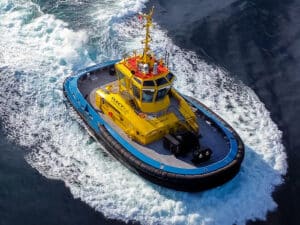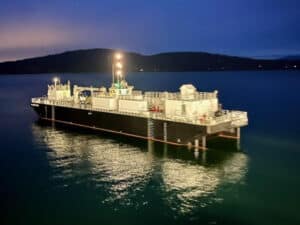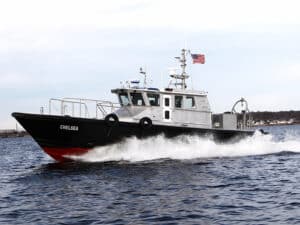
Study: Best practices to tackle tug/towboat crew fatigue
Written by Nick Blenkey
AWO's Jennifer Carter: We look forward to working with the Coast Guard and our other government partners to incorporate the TRB study recommendations into our ongoing efforts to ensure that towing vessel crew members consistently obtain the quantity and quality of sleep they need
FEBRUARY 10, 2015 — The American Waterways Operators has hailed a study conducted for the Transportation Research Board of the National Academies of Sciences, Engineering and Medicine that finds “there is currently no scientific data to support … a change in hours of service” for towing vessel crew members.
“The TRB study is the latest contribution to a growing body of scientific research in multiple transportation modes that demonstrates that splitting sleep into two periods can be a safe and effective way to manage fatigue in 24/7 operating environments like the tugboat, towboat and barge industry,” said Jennifer Carpenter, AWO Executive Vice President & Chief Operating Officer. “AWO and its members have been working with the Coast Guard to prevent and manage fatigue risks in our industry for nearly two decades. We look forward to working with the Coast Guard and our other government partners to incorporate the TRB study recommendations into our ongoing efforts to ensure that towing vessel crew members consistently obtain the quantity and quality of sleep they need to do their jobs safely and to optimize crewmembers’ sleep and endurance within existing industry watch schedules.”
The study’s authors reviewed several recent studies suggesting that when sleep is split into more than one period per day, as in the square watch system in use on many towing vessels, “performance is comparable, and in some cases, better than when the same duration of sleep is obtained in a single sleep period.”
Instead of regulatory changes to hours of service, which “are not likely to be the most effective way to increase sleep durations and improve sleep quality,” the TRB study presents a suite of “evidence-based best practices to improve sleep on schedules requiring a split-sleep period.”
The study recommends that these best practices be linked together by a fatigue risk management system (FRMS) developed as part of a towing vessel’s safety management system.
Here’s what the study says on proposed best practices
The need for best practices related to sleep/fatigue in the tug/towboat/barge industry is not new; in fact, it has been 12 years since the USCG published the report Crew Endurance Management Practices: A Guide for Maritime Operations (Comperatore and Rivera 2003), and 10 years since an addendum (Emond et al. 2005) was published. The basic proposal was for tug/towboat/barge operators to establish a crew endurance management system (CEMS) that could be adopted across the industry to reduce fatigue on board vessels in order to reduce accidents that were due, at least in part, to fatigue. Many of the recommendations involved improving the work environment and scheduling changes that would enhance sleep quality and duration. While many of the recommendations were adopted by some parts of the maritime industry, surveys of 40 wheelhouse crew members and management from 46 companies have established that a CEMS is not well represented in the industry and there has been little attempt to measure if the recommended best practices in a CEMS actually increased sleep time or reduced fatigue. Furthermore, over the past few years a number of advances have been made in understanding the key role of split-sleep schedules and napping, in addition to new technologies and approaches, to control fatigue. These findings can now be incorporated into the best practices to enhance sleep duration and sleep efficiency.
Based on the findings of the current research and the investigators’ experience and knowledge, the following best practices are proposed for implementation in the U.S. tug/towboat/ barge industry.
- Develop and implement a Fatigue Risk Management System (FRMS).
- Develop updated educational materials and standardize dissemination and testing practices.
- Establish stress management policies/programs.
- Monitor and develop strategies to reduce the impact of excessive commute times.
- Implement fatigue reporting practices/fitness-of-duty requirements.
- Provide health and wellness programs.
- Consider establishing a registry of registered medical examiners.
- Initiate screening and guidelines for management of sleep disorders, in particular, obstructive sleep apnea.
- Develop programs for ongoing monitoring and review of all best practices.
- Provide access to good nutrition.
- Provide access to exercise equipment and resources.
- When applicable, utilize fatigue modeling.
- Enhance the sleep environment.
- Encourage and support split-sleep strategies when appropriate.
Develop a process for crew to report missed sleep opportunities and practices to address any related fatigue.
The key that can link all of these practices is a well-developed FRMS that can be developed as part of a company’s SMS. It will also be important to fully assess the implementation by tug/towboat/barge personnel of existing educational materials, such as the USCG Crew Endurance Management Practices site (http://www.uscg.mil/hq/cg5/cg5211/cems.asp) and other industry materials, to aid in the optimization of such strategies.
Download the study HERE





Leave a Reply
You must be logged in to post a comment.